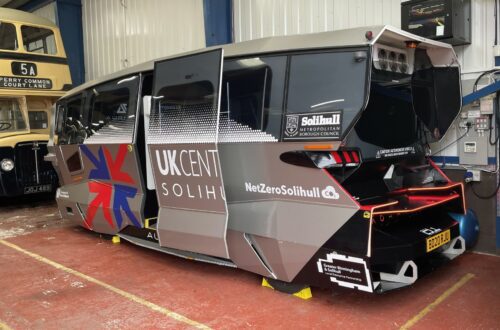
Is this the most modern transport museum exhibit yet? Transport Museum Wythall has taken delivery of an Aurrigo Auto-Shuttle, reports Jonathan Welch
Transport Museum Wythall has acquired a very modern exhibit in the shape of an Aurrigo Auto-Shuttle, an example of what is said to be the world’s first conventionally driven electric and autonomous purpose-built vehicle. Aurrigo designed, developed and built this autonomous vehicle at its Advanced Engineering Centre in Coventry, supplying the type for evaluation in locations across the UK including Cambridge, Milton Keynes and Solihull.
Transport Museum Wythall says it is proud to have been offered the prototype of tomorrow’s technology for permanent display as a static exhibit now that it has completed its research and development programme, allowing it to tell the story of over 120 years of public transport, from its 1912 Tilling-Stevens petrol-electric double-deck bus to driverless autonomy, with particular importance for its education programme and school visits. The vehicle on display was used by Solihull Council as part of a study into the feasibility of self-driving mass transit solutions across the UK.
The shuttle was purchased using funding provided by the Greater Birmingham & Solihull Local Enterprise Partnership (GBSLEP), making Solihull Council the first local authority in the country to own and operate its own autonomous shuttle. This shuttle was first tested at the NEC in 2020, where it operated autonomously along a one-mile pre-mapped section of Pendigo Way between the site’s Atrium and Resorts World areas, where it is reported to have transported over 1,000 people during the four-week test period. It also took part in subsequent passenger trials at Birmingham Airport and Birmingham Business Park.
Carrying up to ten passengers, the vehicle uses a suite of LIDAR scanners (laser imaging and detection), cameras and sensors and sophisticated software to detect, measure and understand its surroundings, allowing it to move around safely, interacting with live traffic and street furniture with little or no operator input. Solihull Council was the first local council in the UK to purchase its own zero-emission, road-legal, shared use Connected Autonomous Vehicle. The trial was all about investigating how to practically and safely start
to incorporate autonomous vehicles into the future transport infrastructure.
The shuttle is presented in the Solihull Council livery it carried whilst running its demonstrations in the Borough (which is appropriately local to Wythall) with on-board audio visual displays showing its background history and test films.
The Museum says it is grateful to Solihull Metropolitan Borough Council for its donation of the shuttle and to Aurrigo for its technical support in converting the vehicle to a static exhibit, with audio visual stories being told on screen. For insurance and safety reasons, the traction battery has been removed. It is now on display amongst the museum’s wide range of buses and battery-electric vehicles from across the decades.

